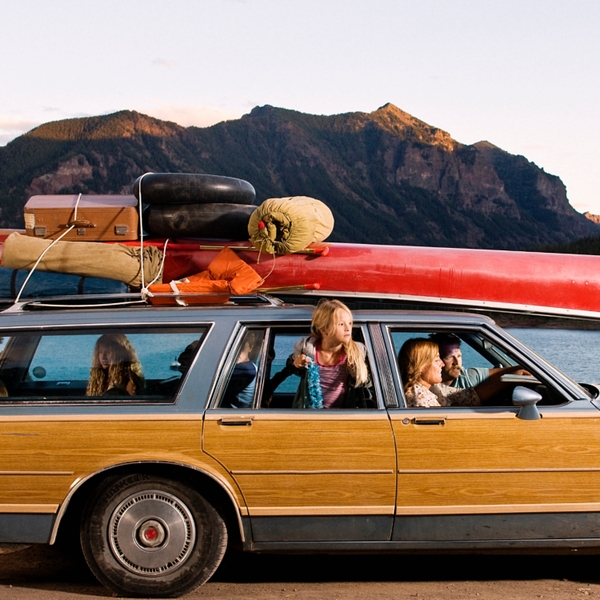The Ultimate East Coast National Parks Road Trip
From Acadia in Maine to the Everglades in Florida, this road trip hits seven national parks, covers 1,800 miles, and guides you away from the crowds
New perk: Easily find new routes and hidden gems, upcoming running events, and more near you. Your weekly Local Running Newsletter has everything you need to lace up! .
How’s the saying go? “It’s not the destination, it’s the journey.” But if you want to connect the most spectacular East Coast national parks and experience the best adventures in between them, maybe the saying should go: “It’s not just the destination, because the journey is kickass, too.”
Follow our plan, and you’ll surf iconic breaks, paddle wild rivers, climb storied cliffs, and find yourself in miles of empty, stunning wilderness. Set aside a couple of weeks to complete the whole drive, or carve off one leg at a time.
Bar Harbor, Maine to Harrisonburg, Virginia
Distance: 789 miles
Route: You’ll start in Bar Harbor, at Acadia National Park, then head south along I-95 all the way down to Virginia, with stops in Rhode Island and Pennsylvania.
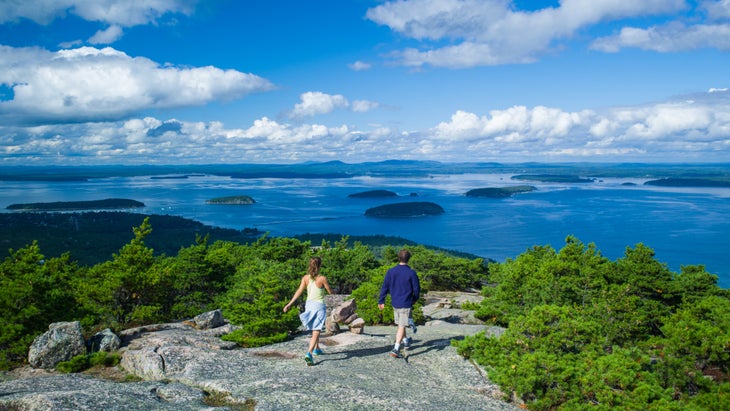
The Park: If you’re seeking dramatic coastline, Acadia National Park has that in spades. The park covers 47,000 acres of cliffs and islands that punctuate the Atlantic Ocean. The majority of it is centered around Mount Desert Island, home to Cadillac Mountain, which rises 1,527 feet from the edge of the ocean. Cadillac is the focus of most visitors—the scenic drive or a challenging hike to the top delivers all-encompassing views of Acadia’s cliffs and bays below.
Skip the crowds and get a taste of the dramatic coastline by hiking on the . Unlike the rest of Acadia, the Schoodic Peninsula is on the mainland, and yet somehow is more secluded and less popular. The scenery is similar to what you find on Mount Desert, as granite headlands, rocky beaches, and gnarled coves meet the Atlantic. A 7.5-mile network of hiking trails traverses the peninsula, ranging from coastline rambles through pine forests to steep climbs up granite knobs. Hiking Schoodic Head is the highlight. You can take the 1.1-mile Anvil Trail up the southeastern flank of Schoodic Head, which stands 440-feet above sea level, or the shorter but more technical half-mile East Trail, which requires some hand-over-hand scrambling to reach the summit. Either way, you’ll be greeted with long range views of Acadia, lighthouses along the coast, and lobster boats and islands dotting the Atlantic below.
Need to Know: You can drive or bike the six-mile, one-way road that traverses the peninsula, but there’s also a park shuttle that will drop you and pick you up at any point along the road.
Stay: The newly renovated seaside are on Mount Desert Island, putting you on the doorstep of Acadia’s action. Choose from 30 cottages and a 10-room motor lodge. Either way, you have access to hot tubs, a pool overlooking Frenchman Bay, and grab-and-go picnic lunches. From $399 for a motor lodge room, $525 for cottages.
Eat and Drink: The takeout-only on the north end of Mount Desert has arguably the best lobster roll in town, served classic Maine-style with a little bit of mayo on a grilled bun. They’ll deliver to your campsite or cottage, too.
���ϳԹ��� Along the Drive: Rhode Island might be tiny, but it boasts 400 miles of coast with some of the best surfing in New England. The town of Narragansett is the hub of surfing culture and offers the most consistent summer break at Narragansett Town Beach. Beginners and longboarders will get the most out of the mellow beach break. If you’re looking for a point break with more energy, head to Point Judith, which sits in the shadow of a scenic lighthouse.
Detour: Hang a hard right into Ohiopyle, Pennsylvania, to , the birthplace of rafting culture on the East Coast. The Upper Yough is the most exciting as it drops 115 feet per mile for five miles through a wild, boulder-choked canyon. Then push on down to Virginia.
Harrisonburg, Virginia to Fayetteville, West Virginia
Distance: 167 miles
Route: This is a shorter but no less worthy stretch of road, the highlight being Virginia’s Shenandoah National Park and some gorgeous mountain drives along the way.
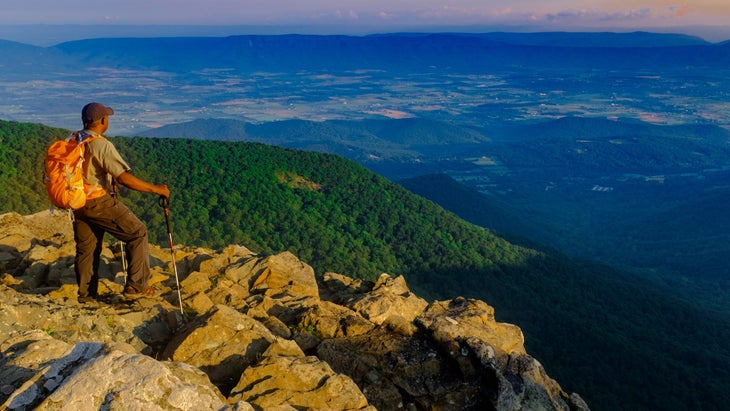
The Park: Just 75 miles west of Washington, D.C., Shenandoah National Park protects a particularly pretty stretch of the Blue Ridge Mountains, offering a quick getaway for denizens of the Mid-Atlantic. And they show up—nearly 1.6 million of them visited the park in 2021. But most stick to the 101-mile-long Skyline Drive, which draws a line through the middle of the park, or flock to the summit of Old Rag, a dramatic, rocky peak with tough climbs and killer views. To avoid the crowds, try the 3.4-mile loop hike. Or bring your fly rod. The park is packed with pristine backcountry trout streams, 70 of which hold healthy populations of native brook trout. Rapidan River, a headwaters stream, offers cool history along with its bevy of trout, as President Hoover established a mountain retreat where two streams join to form the Rapidan.
Need to Know: You can year-round in Shenandoah, but Rapidan is catch and release only.
Stay: puts you in the heart of Shenandoah, as the park lodge occupies 27 acres off milepost 41 of Skyline Drive. Even better than the location are the digs: newly renovated rooms and cabins are well appointed, and the mountain views from 3,680 feet are stunning. Grab a suite (from $254) and lean into the lack of connectivity—there’s no cell service and Wifi is limited to the lobby.
Eat and Drink: A staple in the small town of Harrisonburg, the focuses on organic ingredients sourced from farms within the Shenandoah Valley. The result is elevated comfort food, like the Chop House meatloaf, a blend of local beef and pork paired with collards and mashed potatoes. Wash it down with a seasonal old-fashioned with house-made orange syrup.
���ϳԹ��� Along the Drive: About 60 miles away in nearby West Virginia, Seneca Rocks National Recreation Area is a hotbed of traditional climbing with hundreds of established multi-pitch routes that traverse the mountain’s unique fins of Tuscarora quartzite, which rise from the canopy like a dragon’s back. If you have time, sign up for a , where you’ll master anchors and protection placement.
Detour: The bucolic is surrounded by some of the most dramatic mountains in West Virginia, which is blessed with more than 100 miles of technical singletrack. Most of that singletrack begins and ends in the tiny town of Davis, which has all the bare necessities: a bike shop, great pizza, and a brewery. From here, it’s 164 miles to Fayetteville.
Fayetteville, West Virginia to Gatlinburg, Tennessee
Distance: 275 miles
Route: You’ll head deep into the heart of the Southern Appalachians to explore our 63rd and most recently designated national park—New River Gorge, with one of the region’s deepest gorges and some of its tallest mountains.
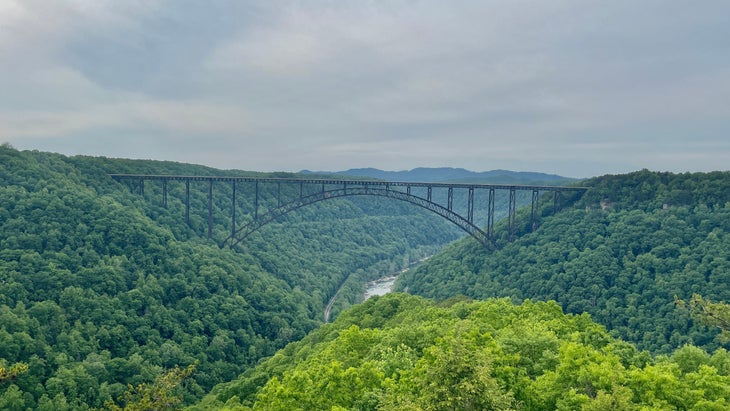
The Park: The 70,000-acre New River Gorge National Park protects some of the best whitewater rafting and rock climbing on the eastern seaboard. Less known? The 13-miles of singletrack built specifically for mountain biking. Hit on the south side of the gorge for fast and pedaly flow through a dense hardwood forest. The three-mile long Adena loop has the toughest climbs and quickest descents.
Need to Know: Unlike many national parks, bikes are allowed on a variety of trails throughout New River Gorge, including some non-technical paths that cruise by historic mining camps.
Stay: The cabin-heavy sits on the rim of the New River Gorge, with a 350-acre campus packed with ziplines, pools, aerial adventure courses, and low key restaurants. The resort’s in-house guides will take you climbing and rafting, too. Choose from tent sites to deluxe cabins (from $39 for camping to $319 for deluxe cabins).
Eat and Drink: is an institution and still the go-to gathering place for climbers and boaters exploring the New. You can get standard pies, but live a little and get one of their signature creations, like the Tajin-spiced Street Corn pizza. The beer list is the best around, too.
���ϳԹ��� Along the Drive: Take a quick detour back into Virginia on your way to Tennessee to stop at the 200,000-acre —5,279-foot Rogers is the tallest peak in the state. Start in Grayson Highlands State Park and hike four miles through high-elevation mountain balds, scramble over rock outcroppings, and spy the herds of feral ponies that live free range on the ridges. Seriously, they’re adorable.
Detour: Before you hit the Smoky Mountains, soak in one of the only natural hot springs in the Southern Appalachians in Hot Springs, North Carolina. Mineral waters fill tubs in the on the edge of the French Broad River. Book a private tub and make time for a beer at Big Pillow Brewing in downtown.
Gatlinburg, Tennessee to Columbia, South Carolina
Distance: 206 miles
Route: This short route begins on the Tennessee side of Great Smoky Mountains National Park, the most biodiverse in the country, and ends in a serene swamp, with a stop in everyone’s favorite North Carolina mountain town of Asheville along the way.
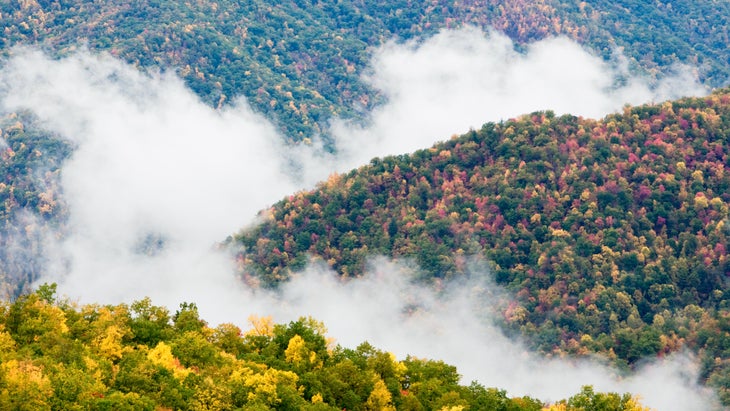
The Park: A little over 12 million. That’s how many people visited the 500,000-acre Great Smoky Mountains National Park last year. That’s the bad news. The good news? Most of those people stick to the scenic roads and short nature trails, which means the best way to ditch the crowds is to hit the backcountry. Head to the less crowded eastern side of the park accessed at a remote entrance to the park off of Heintooga Ridge Road to backpack or trail run the 13.8-mile , which cruises along at 5,000 feet in elevation across mountain top meadows before sinking deep into a forest of old growth poplars, babbling trout streams, and remote campsites.
Need to Know: Backcountry Camp 41 is the best campsite for this loop, and requires a ($4 per night).
Stay: has brought their high-end safari style tents to the Smokies with a 200-acre glamping resort complete with on-site guides and chefs to help you make the most of your time in the park. Expect glamping at its best with king-sized beds, private bathrooms, and delicious meals. From $199.
Eat and Drink: Skip the trail-town madness in Gatlinburg and head to the much quieter Townsend, where traditional Southern fare is given an upscale treatment at the . What isn’t grown onsite is sourced locally. Cheese plates are dressed with home-grown figs, and local trout is paired with tomato jam and grits.
���ϳԹ��� Along the Drive: North of the Smokies, just outside of Asheville, combines professionally built bike jump lines with a 16,000-square foot climbing gym, yoga studio, and bar. Send it inside and out, then cross the street and grab a beer at Sierra Nevada’s sprawling East Coast campus.
Detour: The West doesn’t have a monopoly on epic rivers. in Georgia offers 20 miles of class III-V whitewater in a pristine setting that’s designated Wild and Scenic and was the filming ground for the cult classic film Deliverance. It’s one of the most unique rafting experiences you can get on the East Coast because the number of rafters is limited and groups are spaced out to preserve the remote nature of the river. Knock out eight-mile section 4 for the biggest rapids, or combine sections 3 and 4 as an overnighter with a riverside camp.
Columbia South Carolina to Miami, Florida
Distance: 700 miles
Route: You’ll explore Congaree National Park first and then head south. Sure, this is a long drive down I-95, but think about where you’re headed: Florida’s parks are the domain of white-sand beaches, marine life, and other-wordly wetlands. Plan to take it slow with plenty of stops along the way.
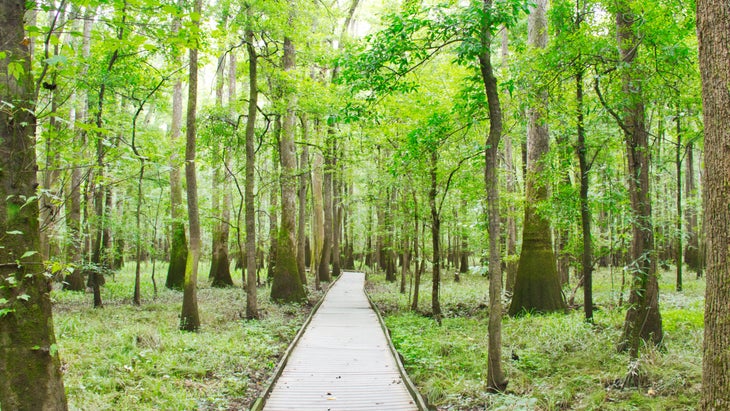
The Park: Congaree National Park doesn’t get the recognition of its neighbor the Smokies, but don’t let the lack of hype—or crowds—deter you. The landscape is unlike any other, as the park protects the largest expanse of old growth bottomland forest in the east. The best way to explore the park is by boat, paddling a canoe along Cedar Creek, where a marked 15-mile trail takes you through gnarled cypress knees and loblolly pines that reach more than 100 feet tall.
Need to know: There’s no current in the creek, so it’s an ideal out-and-back paddling adventure. Show up with your own boats, or rent one in Columbia at (canoes are $50 a day).
Stay: Congaree is just 30 minutes from downtown Columbia, where the 41-room has transformed three historic buildings into a den of modern comfort. And it’s just a block off Columbia’s vibrant Main Street. From $185.
Eat and Drink: In South Carolina, pimento cheese is an art form and ’s makes arguably the best in the state. The hot paninis and meatball subs are worthy, too, but it’s the traditional, or smoked gouda and bacon, pimento cheese that keeps the lights on.
���ϳԹ��� Along the Drive: On your way south from Columbia, don’t miss stopping in the middle of Florida, which is a veritable jungle punctuated by hundreds of natural cold springs that bubble out of the earth and form crystal clear pools and rivers beneath the lush foliage. In the town of Orange City, has a series of springs that feed the St. John’s River, which is a manatee preserve that protects more than 700 of the lumbering sea cows. Paddle the river to spy the manatees, or swim and snorkel your way up the spring to the boil, where the water emerges from the earth.
Miami, Florida to Homestead, Florida
Distance: 40 miles
The Route: While the mileage isn’t high, you’ll want to allow a few days to explore Everglades and Biscayne Bay national parks. The parks are only 20 miles apart, but offer completely different ecosystems and experiences.
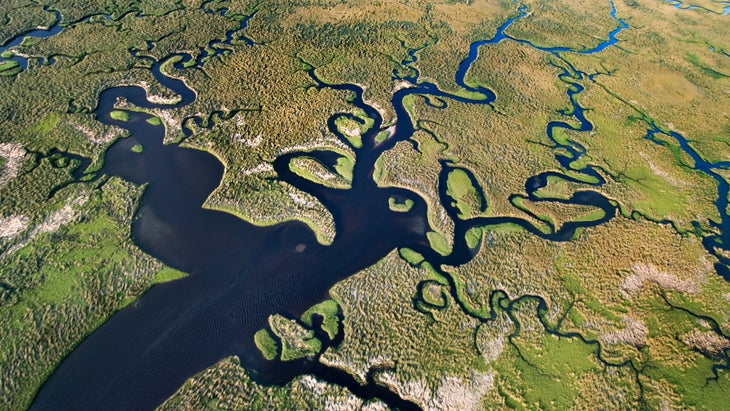
The Park: Everglades National Park is huge—roughly 1.5 million acres—and it’s easy to find solitude in this giant “River of Grass” because most visitors stick to the sub-mile long nature trails and air-conditioned trams. Hop in a kayak or on an SUP and hit one of the dozens of established paddling trails, and you’re all but guaranteed a solo adventure. May through November is the wet season, so expect 90-degree temps with daily afternoon thunderstorms and a lot of mosquitos. But the higher water levels make for the best paddling, and if you get after it early, you can be drinking a beer in a bar before the worst of the heat and thunderstorms hit. Head to Flamingo, the southernmost point in the park, where a variety of marked trails begin. Noble Hammock Trail is a two-mile loop that cruises narrow creeks and small ponds lined with mangroves.
The Park: Sitting in the shadow of Miami, Biscayne Bay National Park is 95 percent water, protecting a tangle of coral reefs, islands, and mangrove forests off the east coast of Florida. Boca Chita Key, with its iconic lighthouse, is the most popular destination, and it has a picture-perfect sandy beach if you’re looking for Insta-gold. But the best of the park sits below the water’s surface along the which links six different historic shipwrecks. Most of these wrecks are shallow enough to be explored via snorkel. You’ll also be able to visit the Fowey Rocks Lighthouse, which rises 130 feet from the water and attracts varied marine wildlife below the surface.
Need to Know: Get if you want to turn your paddle into an overnight adventure in the Everglades. Bring your own boat or rent one from . A boat is a necessity to truly explore Biscayne Bay. You can rent kayaks at the Dante Fascell Visitors Center, or try a guided adventure with the , which offers a variety of snorkel and SCUBA trips starting at $109 a person.
Stay: If you’re fighting mosquitoes in the Everglades, you’ve earned a splurge. This property sits on Key Biscayne, a five-mile-long barrier island just north of Biscayne Bay National Park and within half an hour of the Everglades. (The Florida Keys are just to the south, too.) While you can see the high rises of Miami from the resort, you avoid all the hustle and bustle. The resort has its own golden-sand beach, beachside cabanas, and rooms that overlook the bay (from $440 a night). Meanwhile camping in Florida gets good in the fall and winter when the temperatures drop and the mosquitoes hibernate. offers boat-access-only camping on an island inside Biscayne Bay National Park (sites start at $25 a night). It’s primitive (there’s no running water), but you’ll camp beneath palm trees with the bay just steps away.
Eat and Drink: Ceviche is an art form in Miami and , a Peruvian restaurant and bar in downtown Miami, has been at the forefront of the art scene for more than a decade. You’ll find half a dozen different ceviche options on the menu using white fish, locally-caught seafood, and their signature “leche de tigre” broth.
Detour: Heading further south in Florida, try your hand at looking for tasty crustaceans in the warm water of the Keys. in Florida runs August to March. There’s a strict six lobster limit, and municipalities have different rules as to where you can catch them. Get a permit and check in with the local dive shop about ordinances. A offer guided lobster adventures that will have you snorkeling several feet below the surface to tickle the bugs out of their hiding places.
Editor’s note: As of press time, were still recovering from Hurricane Ian. Of the places listed, we suggest waiting to visit the Florida Keys, as the islands suffered severe flooding and damage during the storm. Miami, Everglades National Park, and Biscayne Bay received minor damage from the storm. Allyson Gantt, a public relations officer for Everglades National Park, says the Everglades fared well in the storm: “Clean up was minimal and things are mostly back to normal. We had locals wanting to get into the park the day after the storm. Come on down. Our local communities will appreciate it.”
If you’re visiting Florida soon, consider volunteering in a local community. organizes current needs and opportunities, from delivering hot meals to working with the American Red Cross.
